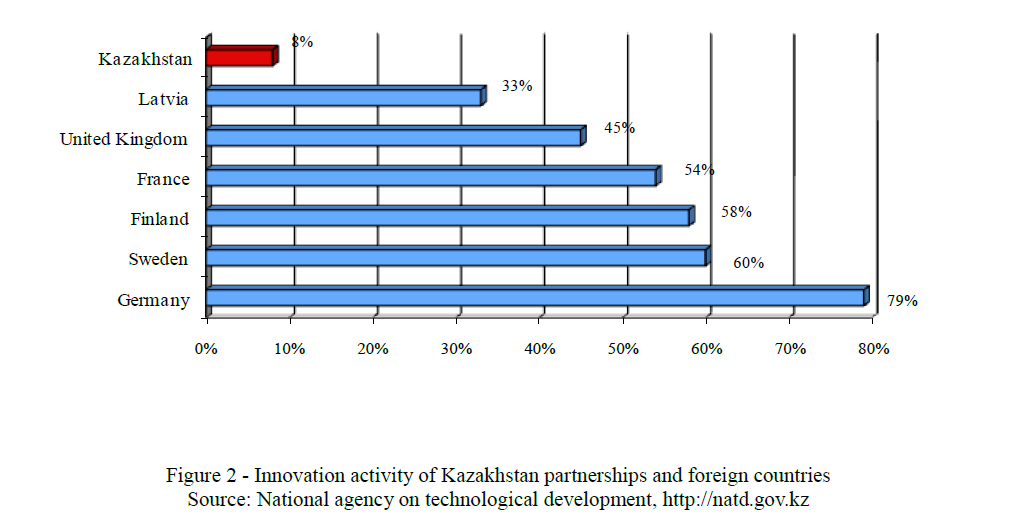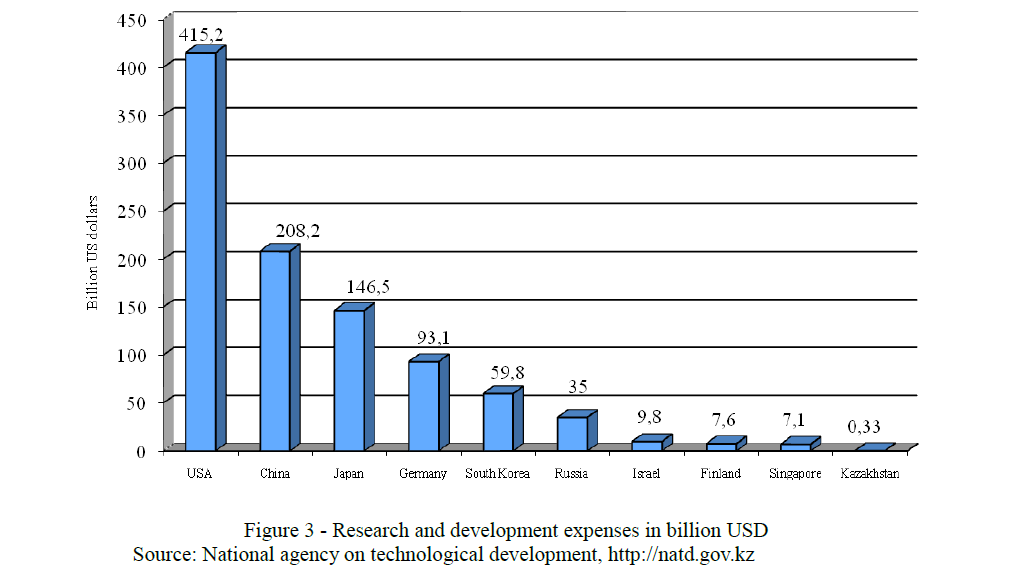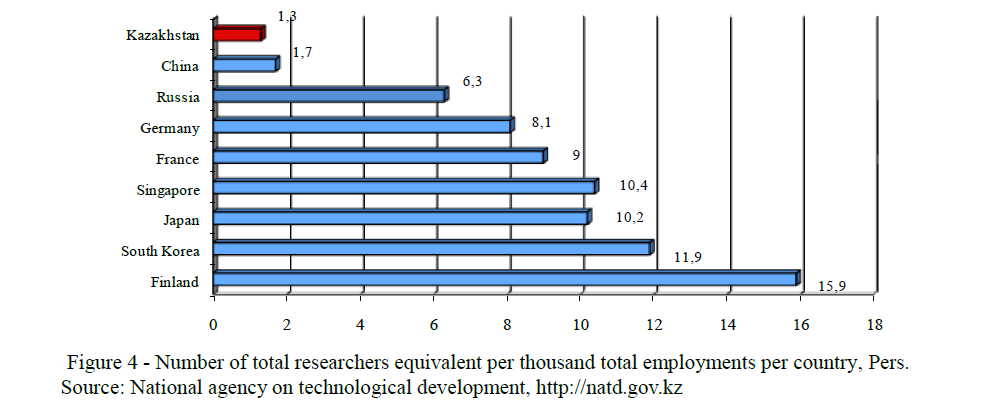The purpose of the authors in this study was to determine key factors that have a major influence on innovative activity of the SME in Kazakhstan. In this paper, statistical analysis of indicators of innovative growth in the Republic of Kazakhstan was conducted. The indicators were compared to those of technologically advanced countries, in particular to such indices as: the share of innovation-active enterprises, domestic spending on research and development (percentage to GDP), total researchers equivalent per thousand total employments, and amount of researches conducted. As the results of the research, key factors that have a major influence on innovative activity of the SME were determined.
1. INTRODUCTION
Nowadays, shares of innovation-active enterprises of all enterprises in Kazakhstan make up to 8.1%. To make a comparison in USA such shares make up to 50%; among the European Union countries highest shares have Germany (79.3.%), Sweden (60%), Finland (58%). Medium share of innovation active enterprises in the European Union compiles to around 53% (National Agency for Technological Development, 2013).
In Kazakhstan, innovation activity of all enterprises of the real sector of economy remains very low; innovative entrepreneurship doesn‟t define overall climate in SME business: in 2014, contribution to the economy by innovative SME made up to 1.5% (Committee on Statistics of MNE RK, 2015).
A shift from export oriented economic model to innovative economics in Kazakhstan is necessary. Today, the State is significantly lagging behind than other developed countries according to innovation driven indices. The Republic of Kazakhstan can be competitive by shifting to a new model of economic growth and by rapidly reducing lag behind. The State needs effective strategy for growth through innovation by implementing the development of commercial innovation.
2. BRIEF LITERATURE REVIEW
Many economists and practitioners focus their attention on the scientific support of innovation management in the economic and social spheres. Individual theoretical and practical aspects are considered in the works of Bianchi et al. (2010), Rothwell and Dodgson (1991), Acs et al. (1997), Edwards et al. (2005), Jenkins (2009), Çakar and Ertürk (2010) and others.
A great contribution to the theory of innovation within the changing paradigm of higher education is made in the works of Kurmanov et al. (2015), Yeleussov et al. (2015).
Kazakh scientists also try to determine factors that have a major influence on innovative activity of the SME, Dana (2010), Radosevic and Myrzakhmet (2009), Smirnova (2013). However, a significant number of scientific issues that are related to effective state management of innovative processes within the economy remain outstanding in the context of Kazakhstan.
3. METHODS
In order to evaluate key factors, which have an influence on innovation activity of SME, Committee on Statistics of MNE RK statistical d a t a w a s u s e d . R e s u l t s o f research were derived from: the sample group analysis of 24,068 SMEs in 2014 and 8,022 SMEs in 2004 SMEs holding their activities in the Republic of Kazakhstan, statistical data, expert‟s opinion on the innovation potential of the State.
4. RESULTS AND DISCUSSION
4.1. Key indicators of innovative activity of enterprises
From the moment of following industrialinnovative development in 2003, Kazakhstan had reached a peak of the main innovation activity indicators in 2014. Positive growth was caused mainly by successful realization of “The state program for accelerated industrial innovative development of Republic of Kazakhstan” in 2014.
To draw comparison: in USA shares of innovation active enterprises make up to 50%; among the European Union countries highest shares have Germany (79.3.%), Sweden (60%), Finland (58%). Medium share of innovation active enterprises in the European union compiles around 53%. (Figure 2) (National Agency for Technological Development, 2013).
Research and development expenses are one of the main indicators of innovation activities. Leaders of this indicator are USA (415 billion USD), China (208,2 billion USD), Japan (146,5 billion USD), Germany (93,1 billion US dollars) (Figure 3).
In 2014 in relation to 2005, shares of innovation active enterprises had increased from 3,4% to 8,1% (Figure 1).

Figure 1 Innovation activity of Kazakhstan enterprises (share of innovative products in GDP, and share of innovation led enterprises among all enterprises)
Source: Committee on Statistics of MNE RK, http://stat.gov.kz

Figure 2 Innovation activity of Kazakhstan partnerships and foreign countries Source: National agency on technological development, http://natd.gov.kz

Figure 3 Research and development expenses in billion USD Source: National agency on technological development, http://natd.gov.kz
It is necessary to mention the quick growth of research and development expenses in China. Compared to 2008, this indicator has increased by 1,7 times. Kazakhstan is lagging behind technologically developed countries on the scale of research and development expenses. However, compared to 2011 growth of expenses on research and development in 2013 (61.7 billion KZT) was 42,5 % (National Agency for Technological Development, 2013)
The largest share of research and development expenses in GDP has been Israel (4,38 % of GDP), South Korea (4,03 %), Finland (3,78 %), Japan (3,39 %).
It is necessary to mention, that according to European Strategy 2020, one of the five general target indicators is increasing expenses on research and development in the European Union (EU), up to 3% of GDP. In 2011 the average indicator in the EU was 1,94 %, which is higher than China (1,84 %). Among the other European countries, Finland has one of the highest indicators (3,78 %). Indicator of research and development expenses of GDP in Kazakhstan is still low 0,17 %. However, it is necessary to mention that local science system is in the beginning of future development (National Agency for Technological Development, 2013).
According to number of researches, performed by R&D, Kazakhstan is lagging behind many foreign countries (Figure 4).Analyzing the number of total researches per thousand total employments Finland exceeds Kazakhstan by 12,2 times, South Korea by 9 times, Singapore by 8 times.
Nevertheless, according to local statistics data of 2013 this index has increased compared to 2008 by 59.5% (up until 17,195 people).
Therefore, innovation development in Kazakhstan as well as other factors is restrained by personnel deficiency, capable to manage innovation processes and projects. Despite positive statistics in the scientific sector, science staff in Kazakhstan requires effective State support and additional stimulation.
4.2. Key factors of developing innovation of SMEs
Little activity of SMEs in Kazakhstan in implementing innovation urges the importance of determining factors of low activity and implement actions of developing innovation active processes in SMEs.
Table 1 contains data on evaluating factors affecting innovation activities in the period of 2004 to 2014.
Data of the 10-year period demonstrates change of SMEs opinions on factors, influencing SMEs opportunities in carrying out innovation activities.

Figure 4 Number of total researchers equivalent per thousand total employments per country, Pers. Source: National agency on technological development, http://natd.gov.kz
Table 1 Factors affecting innovational activities, in % from total number of enterprises

According to the enterprisers the most critical factors were: lack of financial resources, and competent personnel. These two factors were mentioned by 41,4 % of questioned SMEs in 2014 and 21,9% SMEs in 2004.
In 2004 SMEs were highly dissatisfied with loan funds. In 2004, 27,2 % of respondents mentioned high interest to borrowed capital. However in 2014, only 3,2% of questioned SMEs, selected the shortage of financial assets, restricting innovation activity.
High economical risks of implementing innovations were selected as one of the significant factors (in 2014 -9,9%, in 2004 20,2%).
The following matters for innovation led by SMEs are essential: they find it unnecessary to implement innovation due to the lack of demand for innovations (in 201434%, in 2004 10,4%), and due on earlier innovations (in 2014 6,9%, in 2004 18,8%).
Another critical matter was the lack of information on new technologies, and undeveloped corporate communications. 1,7% in 2014 and 14% in 2004 of SMEs have stated these problems.
5. CONCLUSION AND RECOMMENDATIONS
The conducted analysis has shown a very low innovation activity of small and mediumsized enterprises in Kazakhstan compared to other countries.
Business communities shall recognize that companies‟ ability to implement innovations can be a powerful trigger to competitive advantage and process effectiveness, which are so important for small companies. Having the understanding that research and development expenses are investments into future development.
Low innovation activity of SMEs together with growth factors (it is important to note, that all factors determined in this paper, were also found in another researches by other experts, only confirms the important of the matter) must be reevaluated by Government. Without institutional change, effective financial mechanism, training and development of personnel, amendments to laws and regulations, development of small and sized enterprises is impossible. Not only innovation led but also business in general.
REFERENCES
- Acs, Z. , Morck, R., Shaver, J. M., & Yeung, B. (1997). The internationalization of small and medium-sized enterprises: A policy perspective. Small business economics, 9(1), 7-20.
- Bianchi, M., Campodall'Orto, S., Frattini, , & Vercesi, P. (2010). Enabling open innovation in small‐and medium‐sized enterprises: how to find alternative applications for your technologies. R&d Management, 40(4), 414-431.
- 3.Çakar, N. D., & Ertürk, A. (2010). Comparing innovation capability of small and medium ‐sized enterprises: examining the effects of organizational culture and empowerment. Journal of Small Business Management, 48(3), 325-359.
- Committee on Statistics of Ministry of National Economics of the RK (2015). The official statistical information. http://stat.gov.kz
- Dana, L. (1997). Change, entrepreneurship and innovation in the Republic of Kazakhstan. Entrepreneurship, Innovation, and Change, 6(2), 167-174.
- Edwards, , Delbridge, R., & Munday,(2005). Understanding innovation in small and medium-sized enterprises: a process manifest. Technovation, 25(10), 1119-1127.
- Jenkins, H. (2009). A „business opportunity‟model of corporate social responsibility for small‐and medium‐sized enterprises. Business ethics: A European review, 18(1), 21-36.
- Kurmanov, , Yeleussov, A., Aliyev, U., & Tolysbayev, B. (2015). Developing Effective Educational Strategies in Kazakhstan. Mediterranean Journal of Social Sciences, 6(5), 54-61.
- National Agency for Technological Development (2013). Information-Analytical Report "On development trends of innovation in the Republic of Kazakhstan and in the world". natd.gov.kz (in Russ.).
- Radosevic, S., & Myrzakhmet, M. (2009). Between vision and reality: Promoting innovation through technoparks in an emerging Technovation, 29(10), 645-656.
- Rothwell, R., & Dodgson, M. (1991). External linkages and innovation in small and medium‐sized enterprises. R&D Management, 21 (2), 125-138.
- Smirnova, V. (2013). The Innovation Infrastructure of Kazakhstan: Why did the Innovation “Boom” not Happen. Quality Innovation: Knowledge, Theory, and Practices: Knowledge, Theory, and Practices, 322-339.
- Yeleussov, , Kurmanov, N., & Tolysbayev, B. (2015). Education quality assurance strategy in Kazakhstan. Aktual'ni Problemy Ekonomiky= Actual Problems in Economics, (164), 142-150.